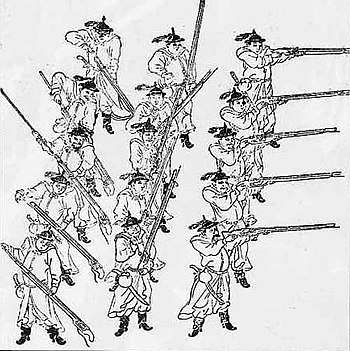Shenjiying

The Shenjiying (simplified Chinese: 神机营; traditional Chinese: 神機營; pinyin: Shénjīyíng; Wade–Giles: Shen-chi ying) was one of three elite military divisions stationed around Beijing during the Ming dynasty. Its name has been variously rendered as Firearms Division,[1] Artillery Camp,[2] Shen-chi Camp,[3]Firearm Brigade,[4] and Divine Engine Division.
Established during the reign of the Yongle Emperor (1360–1424), the Divine Engine Division was specifically created to specialize in firearm warfare. Later on the division provided half of Qi Jiguang's army with firearms and one cannon to every twelve soldiers.
The other two elite divisions were the Five Barracks Division (五軍營; Wujunying), which drilled infantry in tactical manoeuvres, and the Three Thousand Division (三千營; Sanqianying), which specialized in reconnaissance, mounted combat and signalling. Firearms equipped included the fire lance, fire arrows, cannons, and matchlock guns such as the arquebus.
During the Qing dynasty (1644–1912), there was also a military unit called Shenjiying but was known in English as the Peking Field Force. It was created in 1862 and put in charge of protecting the Forbidden City.
References
- ↑ Charles Hucker, Dictionary of Official Titles in Imperial China (Stanford University Press, 1985), p. 417 (entry 5145).
- ↑ Chan Hok-lam, Cambridge History of China, Volume 7, The Ming Dynasty, 1368–1644, Part 1 (Cambridge University Press, 1988), p. 248.
- ↑ Edward Dreyer, Early Ming China: A Political History, 1355–1435 (Stanford University Press, 1982), p. 193.
- ↑ Chan Hok-lam, "Li Ying", in Fang Chao-ying and Luther Carrington Goodrich (eds), Dictionary of Ming Biography 1368–1644 (Columbia University Press, 1976), p. 890.